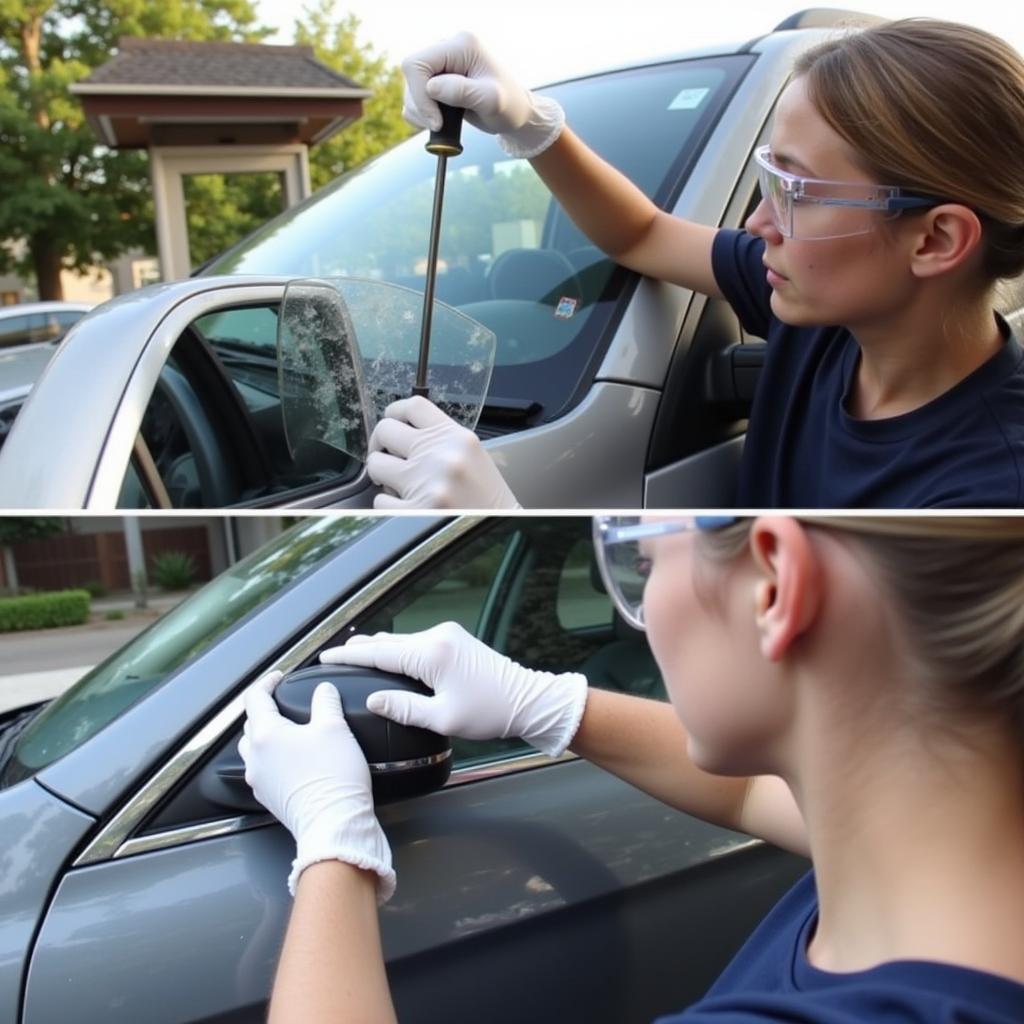Leather car seats add a touch of luxury and sophistication to any vehicle. However, they’re susceptible to cuts, which can detract from their appearance and compromise their integrity. Fortunately, fixing cuts in leather car seats is often possible, allowing you to restore their beauty and prevent further damage. Let’s explore effective methods for repairing these unsightly blemishes. how to fix a cut in a leather car seat
Understanding the Damage: Assessing the Cut
Before diving into the repair process, it’s essential to assess the damage. Is it a small nick, a deep gash, or a tear? The severity of the cut will determine the appropriate repair method. For minor cuts, a simple leather repair kit might suffice. Deeper cuts, however, might require professional intervention.
Knowing the cause of the cut can also help prevent future damage. Was it caused by sharp objects, pet claws, or regular wear and tear? Identifying the culprit can allow you to take preventative measures, such as using seat covers or keeping sharp objects away from the seats.
DIY Solutions for Minor Cuts
For minor cuts and scratches, several DIY solutions can be effective. Leather repair kits, available online and in auto stores, typically contain filler, colorant, and sealant. These kits offer a cost-effective way to repair superficial damage.
Another readily available solution is liquid leather. This flexible material fills in cuts and bonds with the existing leather, creating a seamless repair. Choose a liquid leather product that closely matches the color of your car seats.
Tackling Deeper Cuts: Professional Repairs
Deeper cuts, particularly those that penetrate the leather’s backing, require more advanced repair techniques. In such cases, seeking professional help is recommended. An experienced upholstery specialist can assess the damage and employ techniques like patching or stitching to restore the seat’s structural integrity.
Professional repairs may involve replacing sections of the leather if the damage is extensive. While this can be more costly, it ensures a long-lasting and aesthetically pleasing result.
Preventing Future Damage: Protective Measures
Prevention is always better than cure. Several measures can be taken to protect your leather car seats from cuts and scratches:
- Seat Covers: Using seat covers, especially when transporting pets or cargo, can significantly reduce the risk of cuts.
- Careful Entry and Exit: Avoid wearing clothing with sharp objects, like rivets or studs, that can scratch the leather. Be mindful of keys and other sharp items in your pockets.
- Regular Cleaning and Conditioning: Keeping your leather seats clean and conditioned can improve their resilience and resistance to damage.
- Avoid Direct Sunlight: Prolonged exposure to sunlight can dry out and weaken the leather, making it more susceptible to cuts. Use a sunshade or park in shaded areas whenever possible.
How to Choose the Right Repair Method
Choosing the right repair method depends on the severity of the cut. Small nicks can be addressed with DIY solutions like leather repair kits or liquid leather. Larger cuts and tears, however, usually require the expertise of a professional upholsterer.
“A small nick can often be fixed with a simple DIY kit,” says renowned auto detailing expert, Michael DeVille. “But for significant damage, it’s always best to consult a professional to avoid making the problem worse.”
Conclusion
Fixing cuts in leather car seats can be a straightforward process, depending on the extent of the damage. Understanding the various repair options, from DIY kits to professional upholstery services, allows you to choose the best approach. By taking preventative measures and addressing cuts promptly, you can maintain the beauty and longevity of your leather car seats. Remember, regular maintenance and care can prevent minor issues from escalating into costly repairs. [how to fix car leather scratches](https://autotippro.com/how-to fix car leather scratches/) For personalized assistance with your car seat repair needs, connect with the experts at AutoTipPro. You can reach us at +1 (641) 206-8880 or visit our office at 500 N St Mary’s St, San Antonio, TX 78205, United States.
FAQ
- Can I use super glue to fix a cut in my leather car seat? While tempting, super glue is not recommended for leather repair as it can create a rigid, inflexible bond that can crack or peel over time.
- How long does it take for liquid leather to dry? Drying times vary depending on the product, but generally, it takes between 24 and 48 hours for liquid leather to fully cure.
- How can I prevent my pet’s claws from damaging my leather seats? Using pet seat covers or training your pet to stay off the seats are effective ways to protect your leather.
- Is it possible to dye my leather car seats a different color after repairing a cut? Yes, you can dye your leather car seats after repairing a cut, but it’s recommended to do so professionally for consistent results.
- What’s the best way to clean leather car seats? Use a dedicated leather cleaner and conditioner to maintain the suppleness and integrity of the leather. Avoid harsh chemicals and abrasive cleaners. how to fix hole in car seat
- How much does it typically cost to have a cut in a leather car seat professionally repaired? The cost varies depending on the severity of the damage and the location. It’s always best to get a quote from a reputable upholsterer.
- Can I repair a cut in perforated leather car seats? Yes, but it requires extra care and precision due to the perforations. A professional might be the best option for complex repairs.





Leave a Reply